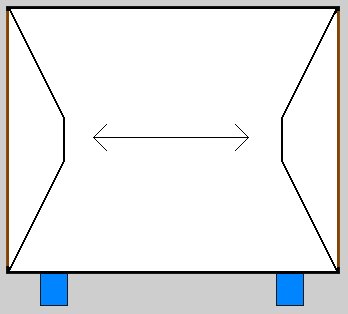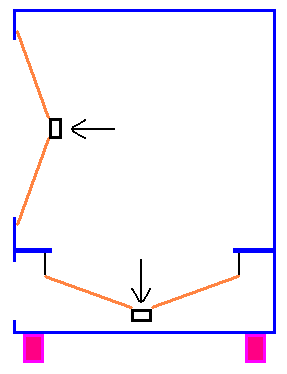Home | Audio | DIY | Guitar | iPods | Music | Brain/Problem Solving | Links| Site Map
This work is licensed under a Creative Commons License.
Everything You Wanted To Know About Speakers
Speaker Sound Coloration | Speaker Driver Design | Speaker Enclosures | Speaker Sensitivity | Ribbon and Electrostatic Speakers | Crossover Networks | Accuracy, Soundstage and Ambience | Impedance | Damping Factor | Subwoofers | Auditioning Speakers
Speaker Sound Coloration
Speakers represent one of the most important choices you can make as to the final sound that you will be hearing in your home entertainment room. They also have a very wide price range, and can be purchased for less than $100 per pair, and up to more than $70,000 per pair. You might ask the question, "what the heck is inside there to make them so expensive?" The answer is similar to why some amplifiers cost so much. The more expensive speakers are generally made in very small quantities, with custom built speaker drivers (see below), and fine cabinet work. In general, you get what you pay for, but the tonal characteristics of each speaker system differ, perhaps more than any other component in a sound system. Thus, it is imperative that you listen to a large number of speakers to find the ones that sound best to your ears. Some will have a bright sound, others a strong midrange, and others a very deep bass. No speaker reproduces the audio spectrum (the human range of hearing) perfectly. They all "color" the sound to varying degrees, regardless of price. This coloration is something built in, depending on the preferences of the designer. Finding speakers that satisfy your preferences takes some time and effort.
Speaker Driver Design
Speakers consist of one or more driver units in a box. The driver is constructed of a metal frame to which is attached a cone, made of paper or plastic and occasionally metal. At the rear end of the cone is attached a coil of wire (the "voice coil") wound around an extension of the cone, called a "former". The two ends of the voice coil are connected to the crossover network, and the crossover network is connected to the speaker binding posts on the rear of the speaker enclosure. The voice coil is suspended inside a permanent magnet so that it lies in a narrow gap between the magnet pole pieces and the front plate. The voice coil is kept centered by a "spider" that is attached to the frame and to the voice coil. A rear vent allows air to get into the back of the driver when the cone is moving, but a dust cap on the cone keeps air from getting in through the front. A rubber surround at the outer edge of the cone allows for flexible movement. In the case of a tweeter, the cone is very light, perhaps made of silk, and is glued directly to the voice coil. It isn't attached to a frame or rubber surround because it needs to be very low mass in order to respond quickly to high frequencies.
When the musical electrical signal from the amplifier passes through the voice coil, the voice coil turns into an electromagnet.
Depending on which way the current is travelling in the voice coil, the north and south pole of the magnetic field will be at one end of the voice coil or the other. The permanent magnet has a north and south pole as well. Its magnetic field will push the coil (and the attached speaker cone) outward if the north and south poles of the two magnetic fields are lined up together (north to north, and south to south), or pull the voice coil inward if they are lined up oppositely (north to south, and south to north). So, as the electrical signal from the amplifier, which is a representation of the original musical waveform, passes through the voice coil, and changes direction with the musical waveform, the voice coil and attached speaker cone are driven outward and pulled inward in time with the music. The speaker cone pushes or pulls air in the room, which translates to increases or decreases in air pressure at your eardrums, and there you have it: music. A one driver speaker is called a "one way". If it has two drivers, one to handle high frequencies and the other to handle the mid and low frequencies, then it is called a "two way". Separate high frequency drivers (tweeters), midrange drivers, and low frequency drivers (woofers) are found in "three way" speakers. You might find a one way speaker in a pocket radio, but home theater and hi-fi speakers are generally two way or three way in design.
Speaker Enclosures
The various combinations of drivers are placed in boxes (enclosures or cabinets) of two basic configurations. The box can be sealed, which is called a closed-box, or have one or more holes, called vents or ports. The simplest design is the vented box. It will usually have the driver at the front of the cabinet, and there will be a vent on the front or back, often at the bottom. Multiple driver vented boxes are common, and the tweeter may be closed off in its own box inside the main box. The next type is the passive radiator speaker. It is a cross between the vented enclosure and the sealed enclosure and has one or more "active" drivers (drivers which are electrically connected to the amplifier) and one or more "passive" drivers which are not electrically connected. Some passive radiators are simply non-electrically connected speakers, while others are flat membranes suspended across an opening in the enclosure. All the drivers are mounted inside a non vented box, facing outward (although the various drivers may be on different surfaces, i.e., front, rear, bottom, etc.) Depending on the frequency, the passive driver may be moving in the same direction as the active driver (into the driver's metal basket or out of the basket), i.e., "in phase", or it may be moving in the opposite direction, i.e., "out of phase". When in phase with the active driver, the passive radiator acts to increase the bass output, whereas if the passive radiator is out of phase, bass output is reduced. At one frequency (the tuning frequency), the active driver hardly moves at all, while the passive driver moves a great deal. At this tuning frequency, the active driver and passive radiator are completely out of phase. On either side of the tuning frequency, the active driver and passive radiator are more in phase, the farther from the tuning frequency one goes. The third type of design, which is called "push pull", uses two active (electrically connected to the amplifier) drivers for the pushing and pulling. One driver is mounted inside the non vented box facing outward, and another is mounted outside, facing inward, with the two drivers electrically connected out of phase so that when the cone of one is being driven outward, away from the magnet, the other is being pulled inward, towards the magnet, both being actively driven by the amplifier. Even ordered harmonic distortion is reduced in this design. The last design is the simple closed-box, with all speakers active, mounted inside the non vented box facing outward, and in phase (all the speaker cones move in the same direction with respect to the speaker magnets at the same time). Such speakers are sometimes called "acoustic suspension".
The direction that the speakers radiate their sound depends on how the drivers are lined up in the enclosure, and also whether there are drivers or ports on the back of the speaker. If all the speakers are on the front, this would be called "direct". If there are speakers on the front and back, and they are in phase (both speaker cones moving away from the magnet - out of the basket), this is called "bipolar", whereas if the the cones are out of phase (one cone moving in towards the magnet, while the other cone is moving outwards, away from the magnet), the speaker design is called "dipolar". If there is simply an open back to the enclosure, then the speaker is considered to be dipolar. This is the case for electrostatic and ribbon speakers.

Animated example of how bipolar speakers works.

Animated example of how dipolar speakers work and what makes a push pull speakers work.
How the sound changes (decreases) as you move away from being directly in front of the speakers (moving to the side) is called the "off axis response". You should test this when auditioning speakers by moving to the side while music is playing. Listen especially for a decline in high frequency sounds. Some speakers will drop off quickly, while others have good "wide angle dispersion", meaning they do not lose high frequencies so much when you sit towards the side rather than directly in front. This is important with home theater where the whole family may be listening to the sound.
Home | Audio | DIY | Guitar | iPods | Music | Links | Site Map | Contact